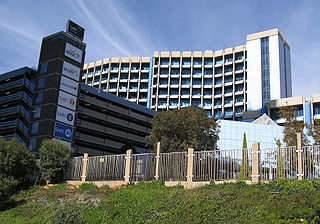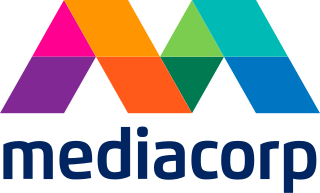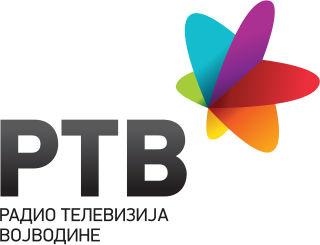Telecommunications in Senegal include radio, television, fixed and mobile telephones, and the Internet.
A television broadcaster or television network is a telecommunications network for the distribution of television content, where a central operation provides programming to many television stations, pay television providers or, in the United States, multichannel video programming distributors. Until the mid-1980s, broadcast programming on television in most countries of the world was dominated by a small number of terrestrial networks. Many early television networks such as the BBC, CBC, PBS, PTV, NBC or ABC in the US and in Australia evolved from earlier radio networks.
Public broadcasting involves radio, television, and other electronic media outlets whose primary mission is public service. Public broadcasters receive funding from diverse sources including license fees, individual contributions, public financing, and commercial financing, and claim to avoid both political interference and commercial influence.
Television broadcasts in the United Kingdom began in 1932, however, regular broadcasts would only begin four years later. Television began as a public service which was free of advertising, which followed the first demonstration of a transmitted moving image in 1926. Currently, the United Kingdom has a collection of free-to-air, free-to-view and subscription services over a variety of distribution media, through which there are over 480 channels for consumers as well as on-demand content. There are six main channel owners who are responsible for most material viewed.
The Senegambia is, in the narrow sense, a historical name for a geographical region in West Africa, named after the Senegal River in the north and the Gambia River in the south. However, there are also text sources which state that Senegambia is understood in a broader sense and equated with the term the Western region. This refers to the coastal areas between Senegal and Sierra Leone, where the inland border in the east was not further defined.

The South African Broadcasting Corporation (SABC) is the public broadcaster in South Africa, and provides 19 radio stations (AM/FM) as well as 6 television broadcasts and 3 OTT Services to the general public. It is one of the largest of South Africa's state-owned enterprises and the biggest state broadcaster in Africa.

The Serbian Broadcasting Corporation, more commonly referred to as Radio Television of Serbia, or RTS, is the state-owned public radio and television broadcaster of Serbia. RTS has four organizational units – radio, television, music production, and record label (PGP-RTS). It is financed primarily through monthly subscription fees and advertising revenue.

Télévision Suisse Romande was a TV network with two channels: TSR 1 and TSR 2. They were the main French-language channels in Switzerland, part of SRG SSR. They provided content for TV5Monde. Radio Suisse Romande and Télévision Suisse Romande merged on 1 January 2010 to create Radio Télévision Suisse.

TV5Monde, formerly known as TV5, is a French public television network, broadcasting several channels of French-language programming. It is an approved participant member of the European Broadcasting Union.

Magyar Televízió or MTV is a nationwide public television broadcasting organization in Hungary. Headquartered in Budapest, it is the oldest television broadcaster in Hungary and today airs five channels: M1 HD, M2 HD, M3, M4 Sport and M5.

Mediacorp Pte. Ltd. is the state-owned media conglomerate of Singapore. Owned by Temasek Holdings—the investment arm of the Government of Singapore—it owns and operates television channels, radio, and digital media properties. It is headquartered at the Mediapolis development in Queenstown's One-north precinct, which succeeded Caldecott Hill—the long-time home of its predecessors—in 2015; as of 2022, Mediacorp employs over 3,000 employees; a large number of them are in both public and private sector broadcasting.
Slovenská televízia was a state-owned public television organisation in Slovakia. It was created in 1991 as the Slovak part of the former Czechoslovak Television and was headquartered in Bratislava. It was funded from a combination of television licence fees, advertising, and government funding. It ceased to existed on 1 January 2011, when it was merged with the state-owned public radio organisation Slovenský rozhlas to create Rozhlas a televízia Slovenska. STV was a member of the European Broadcasting Union.
Radiodiffusion Télévision Sénégalaise (RTS) is the Senegalese public broadcasting company.

Radio Television of Vojvodina (RTV) is the regional public broadcaster in the Serbian province of Vojvodina, headquartered in Novi Sad. Alongside statewide Radio Television of Serbia, RTV serves as the second major public broadcaster in the country. The radio service began in 1949, and the television service launched in 1975. RTV broadcasts in multiple languages, including Serbian, Hungarian, Slovak, Romanian, and Rusyn, later adding Romani and Ukrainian.
Television in Switzerland was introduced in 1950, with regular broadcasts commencing in 1953. People who live in Switzerland are required by law to pay a television licence fee, which is used to finance the public radio and television service SRG SSR. Since 1 January 2021, the Licence fee cost in all the linguistic regions of Switzerland is 335 CHF per year or 83.75 CHF quarterly, counting both radio and television licences. All licence fee payers are entitled under the law to services of equal quality. The fee is charged per household and not per person, with empty dwellings being exempt. The fee is determined by the Federal Council.
2sTV is the second television channel of Senegal.

The Central Television of the USSR was the state television broadcaster of the Soviet Union.
Radio Gambia is the national radio broadcaster of the West African state of the Gambia. Established in 1962, it became the first radio station in the Gambia.

Khar Bii is a television show that has aired annually on 2sTV in Senegal since 2009. As of 2012, it was the most popular show in Senegal. The show is a contest to locate the most beautiful ram in the country and airs each year in the lead-up to the Muslim holiday Eid al-Adha.
Le Bouquet Africain is an audiovisual offer with 36 TV channels launched by Thema on the French market in September 2008 in a soft launch with the French telecommunications operator Neuf. As of 2009 some cable and ADSL operators have also offered this bouquet to their subscribers. It is mainly intended in particular for the population originating in French-speaking countries in sub-Saharan Africa.









